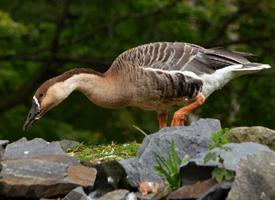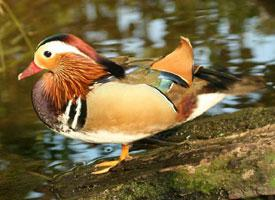
Poids et mesures
| Poids | de 2,8 à 3,5 kg |
|---|---|
| Envergure des ailes | 162 cm |
Description de l'animal
The Swan Goose (Anser cygnoides) is a large, elegant bird that belongs to the Anatidae family, which also includes ducks and swans. This species is native to Mongolia, northern China, and southeastern Russia, preferring habitats such as wetlands, marshes, and large lakes. The Swan Goose is particularly notable for its long neck and distinctive appearance, which makes it a subject of fascination among birdwatchers and wildlife enthusiasts.Adult Swan Geese are characterized by their impressive size, reaching lengths of up to 90 centimeters (35 inches) and weighing between 2.8 to 3.5 kilograms (6.2 to 7.7 pounds). Their wingspan can stretch up to 185 centimeters (73 inches), providing them with powerful flight capabilities. The plumage of these birds is predominantly brownish-grey, with lighter, almost white, feathers adorning their underbellies. Their heads are capped with a darker brown, and a conspicuous white stripe extends from the base of the beak, over the eyes, to the back of the head, adding to their distinguished look.
One of the most striking features of the Swan Goose is its long, graceful neck, which is longer in proportion to its body than that of any other goose species. This elongated neck aids them in foraging for food in deeper waters than their shorter-necked relatives can access. Their diet mainly consists of aquatic plants, grasses, and grains, which they graze on in their natural habitats.
The beak of the Swan Goose is another distinctive characteristic; it is long, tapering, and slightly upturned at the tip. This feature, combined with their long necks, allows them to efficiently forage for food. Their legs are strong and of a pinkish hue, enabling them to walk and swim with ease.
Swan Geese are migratory birds, undertaking long journeys between their breeding and wintering grounds. During the breeding season, which takes place in the spring and early summer, they prefer secluded wetlands where they can nest in peace. The female lays between 5 to 6 eggs, which she incubates for about a month. During this time, the male guards the nest site diligently. The goslings are precocial, meaning they are relatively mature and mobile from the moment of hatching. They are able to feed themselves shortly after birth but remain with their parents for protection and guidance.
Despite their beauty and majesty, Swan Geese are facing numerous threats that have led to a decline in their population. Habitat destruction, due to agricultural expansion and urban development, has significantly reduced their natural living spaces. Furthermore, hunting and egg collection pose direct threats to their survival. As a result, the Swan Goose is classified as Vulnerable on the International Union for Conservation of Nature (IUCN) Red List of Threatened Species. Conservation efforts are underway in many parts of their range to protect these magnificent birds and their habitats, ensuring that future generations may continue to witness their elegance in the wild.
Carte de répartition

Animaux similaires
Nouvelles photos d'animaux
Top 10 des animaux
- Dolphin gull (Leucophaeus scoresbii)
- Diana monkey (Cercopithecus diana)
- Moustached guenon (Cercopithecus cephus)
- Galápagos tortoise (Geochelone nigra complex)
- Japanese macaque (Macaca fuscata)
- Russian tortoise (Testudo horsfieldii)
- Stone loach (Barbatula barbatula)
- Greek tortoise (Testudo graeca)
- Common flying dragon (Draco volans)
- Vendace (Coregonus albula)


